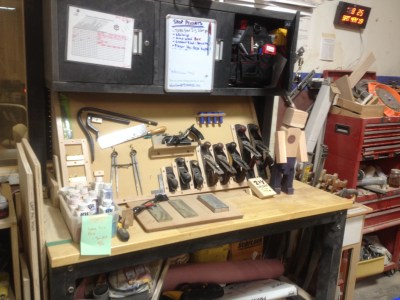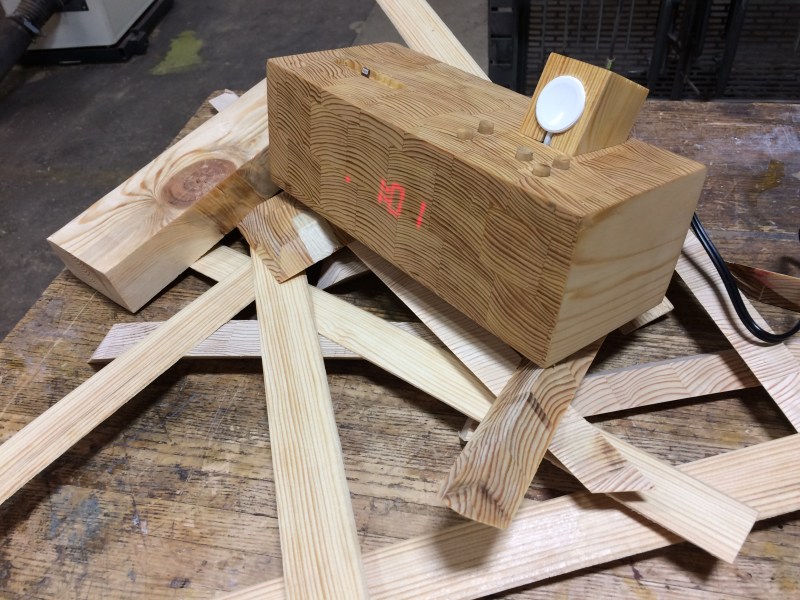The 2×4 Contest at my local hackerspace captured my interest. The challenge was to build something cool out of a single eight-foot 2×4 with the winner getting free wood storage in the space. I had half an idea for a project, but I ran out of time and never even started it. My idea was to cut the board into half-thickness strips and glue them edge-to-edge with some biscuits holding them together — to basically make wider, thinner boards to do… something cool with it.
One of the entries is pictured above. [Jon Alt] designed this clock and phone charger that includes a capacitive charger for his smart watch. He makes use of the 2×4’s grain to make a gorgeous enclosure, carving away the rear of the front panel so only a credit-card’s thickness of wood remained, allowing the 7-segments to shine through. The other entries were great as well and I especially liked the 2×4 guitar.
 Mostly what interested me about the contest was what it showed about the wood shop: thanks to the volunteers and board, that is a wood shop doing well. Stuff is going on! A sad wood shop doesn’t hold contests. By extension, when the shop is doing well, that means the hackerspace is also doing well.
Mostly what interested me about the contest was what it showed about the wood shop: thanks to the volunteers and board, that is a wood shop doing well. Stuff is going on! A sad wood shop doesn’t hold contests. By extension, when the shop is doing well, that means the hackerspace is also doing well.
A wood shop is one of those areas of a hackerspace that is tool-driven. It’s not just a gathering place for like-minded folks; people go to use a specific tool or tools they can’t afford, and let’s face it, there’s always tools to buy that costs a bunch of money.
I’ve seen this particular shop begin as an empty concrete room with a cheap drill press and someone’s old bandsaw. Pretty soon worktables, shelving, and storage were built. More tools arrived, some donated, some loaned, some purchased with dues. So how can other spaces replicate this wood shop success story?
The Hack Factory has a morticing machine that the board paid for. The spindle sander is a loaner, and the standing saw is rumored to be as well, though it’s been in the space since at least 2013. A sound-dampening box was donated by an acoustic paneling company to house the belt sander’s shop-vac dust collector. With every donation or loan or purchase, the shop gets stronger. Here’s why: when the space does well, the board has money to spend on new tools. Cool tools attract new members who want to use them, so everyone wins.
I especially love seeing communal projects done to improve the space. The wood shop folks built a lovely rack for their collection of block planes, and I honestly have never seen a better way to display the clunky tools. [Jon] assembled a Moxon vise (pictured to the left) on hardware which was donated by Benchcrafted. We bought a Saw Stop and quickly filled up a wall with burnt-out cartridges.
Less elegant but just as useful, shop regulars built a rack for the shop’s extensive collection of tube clamps, part of their One Day Builds project that encourages members to actually finish the project before they leave, in many cases allowing the project to actually get finished.
The secret to success is to build into your schedule these social activities which bring the veteran woodworkers together and attract the beginners looking to get started. It’s not a place to dump tools but a space to socialize, to ask for help and answer questions, and to build a story into every creation you work on. I want to hear what’s going on in your wood shop. Leave a comment with some details. And don’t forget to give a shout out to your wood shop manager for changing blades and hauling out bags of sawdust — [Jon Alt], that means you.
















“One of the entries is pictured above. [Jon Alt] designed this clock and phone charger that includes a capacitive charger for his smart watch. ”
All I see is a pile of scrap lumber.
Oh, Never Mind! Once the article is fully open, ALL of the top picture is seen, including the top of the “board”.
I have a nice woodshop and tools, if only there was a local hackerspace I could loan power tools too.
Yes, having a couple of basic tools, such as a drill and saw, allows benches, shelves, and jigs to be built.
Wood magazine is currently running a series informing people just starting in woodworking how to build a workshop with tools and fixtures over time with just $150(?) per paycheck.
during a period of depression I got into wood working. One thing i noticed as ive expanded into plexi and aluminium (riveted as i cant afford a mig or tig yet) is its sometimes cheaper to buy an additional tool from a place like harbor freight than to just make a few cuts with a tool you know you may bring out of spec/current working condition. Example. I had a 35 buck 80tooth blade for my 10inch miter saw. It worked great for wood and plexi. The plexi cuts were good enough to achieve a water tight weld with maybe 30seconds of sanding pre acetone aplication. after two cuts of aluminium (thin ass L pieces) this is no longer true. Had i bought a 35 buck cut off mini chop saw from harbor i would have been able to cut that till my hearts content with out spending again for a new 10inch blade.
thought id add that to any advice in the said artical
What are you guys doing that you have a whole collection of burnt out brake cartridges?
You should probably reassess who gets to use the saw and the safety surrounding it.
Powertools are fun and save time, but don’t forget hand tools can do all the same tasks for less investment in money.
They haven’t had “an incident” in over a year, apparently.
Hi! I’m a member (and board member) of the shop in question here.
Every instance that I’m aware of our SawStop brake firing has been caused by user error so far, basically people sawing wet wood, or wood with nails or staples in it, and one time the riving knife was adjusted wrong and vibrated itself against the blade which set it off.
If it was set off because of a finger or something like that, the blade wouldn’t end up on ‘the wall of shame’, because we could send it back to SawStop for a replacement instead in that case.
Also, we require anyone who uses the table saw to get specific training because of the SawStop. And people are unfamiliar with any tools, we ask them to please ask someone to show them the ropes before using them.
“part of their One Day Builds project that encourages members to actually finish the project before they leave, in many cases allowing the project to actually get finished.”
Can somebody elaborate? =)
I suspect a lot of hackerspaces are crowded with “half finished” projects. Some have taken the initiative to clear out stuff by helping members get their projects completed.
I suspect that you missed his [CRImier]’s wink at the end. I laughed, anyway.
However, there’s an error in your first sentence: “I suspect a lot of hackaday editor’s desks are crowded with “half finished” projects…” is corrected.
But I think we’re all on the same page in some way: small projects that can be completed quickly, or at least taken to the next identifiable stage in one session, are a lot more likely to get done, no?
Maybe, but a lot also depends on the maker. I had a project I was working on at TCMakers for 4 years. But I was there most weekends working on it, and it was (necessarily) broken down into many sub-projects (each of which would be nearly pointless until the whole thing was done, and often required careful fitting to the entire assembly).
Point being, the scale of the project matters less than the dedication to getting it done.
One example is the rack for all the tube clamps. It was made ugly but strong out of 2x4s, and everyone committed to staying until the project was done.
How much tonnage do you think it takes for closed die drop forging of wood?
Hey y’all. Watch this…
One thing about the woodshop is that it’s self-replicating. The fabric/textiles area can’t exactly sew new shelving units, but the woodshop has the means to expand itself from a basic installation.
That’s a good point!
This article has a good point. As a long-time TechShop member in Silicon Valley, I’ve noticed that the two things that new members use are the laser cutters and the wood shop. Few people use the milling machine, and fewer still the electronics bench.
This is useful and suggest everyone pursue a hobby in serious woodwork…. as prep for the next Carrington Event.